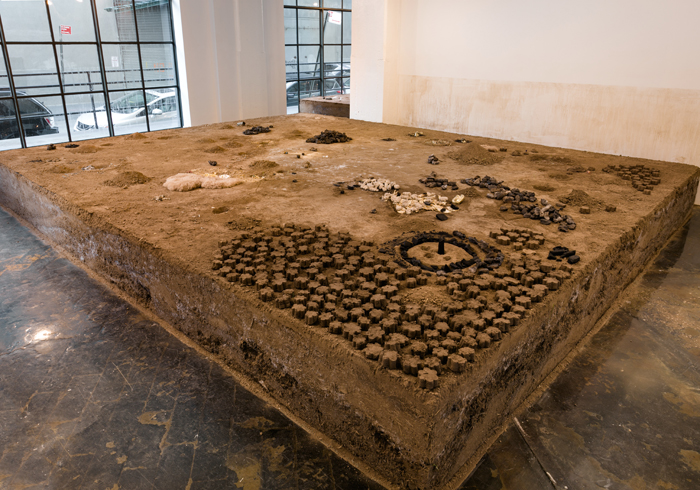So complex are the fragile constellations of Dineo Seshee Bopape’s practice that her sculptures evade the easy didacticism of a casual description. But here goes: an egg-shaped form rests alongside a strip of compressed soil decorated with womb-healing herbs and minerals, casts of a uterus and curved lumps of clay rendered by a clenched fist.

I first encountered her work in 2015 while we were both on residency at Hospitalfield in Arbroath, Scotland. In conversation, she spoke about sonically mapping the continental rivers of Africa, before shifting focus to talk of “cosmological beliefs” and “voodoo priestesses”. The substance of Bopape’s practice is as various as her intellectual interests, and becomes even more magical as she begins to elaborate. Through her use or misuse of the language of Postconceptualism, Bopape’s work reveals something of the sculpture’s inherent porosity, forms might feel random but rarely accidental. For the past year or so, her work has grappled with questions of individual, collective and planetary sovereignty through a broader meditation on the Anthropocene. The outcome is a chorus of codependent forms bound by a sense of containment, displacement and the sociohistorical politics of land and landlessness. While they may not ‘represent’ the artist’s experience of growing up in Polokwane, South Africa, they appear to speak of a specific use of language and poetics both rooted in personal meaning.

The violent objects of collective memorytaken up in the Rhodes Must Fall protest movement’s call to ‘decolonise’ education across South Africa, resonates with Bopape’s ongoing interest in the reconfiguration of a history shorn of its ideological limitations. The trace of Afro-diasporic traditions can be seen in +/-1791 (monument to the haitian revolution 1791), presented at the Sharjah Biennial in 2017, a homage to Haiti’s revolution against French colonial rule. This work seems to lay the ground for her contribution to the fourth edition of the Future Generation Art Prize, recently presented in Venice: slabs of soil are covered with feathers, wax, crystals, gold leaf (a reference to the gold rush that led to the founding of Johannesburg), shells and, again, the same fist-indented lumps of clay. Its spiritual aesthetics suggests a kind of ideological inversion of Land art, speaking to the landlessness of Africa’s indigenous majority as an ongoing sociopolitical trauma, and to the dispossession of land under colonial orders that led to precarious conditions of soil. Like the palm-clenched clay, her work mediates between the self and the object; it can be formed into something or simply disintegrate back to dust.
Dineo Seshee Bopape lives and works in Johannesburg. In 2017 she won both the Future Generation Art Prize, awarded by the Pinchuk Art Centre, Kiev, and the Sharjah Biennial Art Prize. She has recently shown work at Witte de With Center for Contemporary Art, Rotterdam, and the Jakarta Biennale and National Arts Festival Grahamstown (all 2017). A solo exhibition, 222, Phurulloga, is on show at Bielefelder Kunstverein through 28 January. In 2018 she will present work at the Victor Pinchuk Foundation, Kiev; Collective Gallery, Edinburgh; Baltic Centre for Contemporary Art, Gateshead, and The Mistake Room, Los Angeles.
Osei Bonsu is a British-Ghanaian curator and writer based in London. He is the curator of the tenth edition of Satellites, titled The Economy of Living Things (2017), a four-artist exhibition at the Jeu de Paume, Paris, and CAPC Centre for Contemporary Art, Bordeaux, that focuses on revealing migration routes of people, animals, plants, goods and ideas through zones of conflict.
From the January & February 2018 issue of ArtReview, in association with K11 Art Foundation
